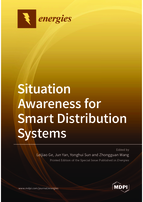Situation Awareness for Smart Distribution Systems
A special issue of Energies (ISSN 1996-1073). This special issue belongs to the section "F2: Distributed Energy System".
Deadline for manuscript submissions: closed (25 February 2022) | Viewed by 25742
Special Issue Editors
Interests: RFID; intelligent distribution network situational awareness technology; renewable energy grid integration optimization control technology; artificial intelligence empowering distribution networks/microgrids; and intelligent distribution power big data cloud computing technology
Special Issues, Collections and Topics in MDPI journals
Interests: computational intelligence and cyber-physical security with applications in smart grids; smart cities; and other smart critical infrastructures
Special Issues, Collections and Topics in MDPI journals
Interests: power system state estimation; load forecasting; smart distribution network
Special Issues, Collections and Topics in MDPI journals
Interests: operation of renewable power generation; active distribution system energy management
Special Issues, Collections and Topics in MDPI journals
Special Issue Information
Dear Colleagues,
As a key application of smart grid technologies, the smart distribution network (SDN) is expected to present a high diversity of equipment and complexity of operation patterns. Situational awareness (SA), which aims to provide critical visibility of the SDN, will be the enabling technology in the assurance of stable SDN operations, and inadequate SA has been identified as one of the causes of several recent large-scale electrical disturbances worldwide. One of the main reasons for the SA inadequacy has been the lack of accurate and reliable data-acquisition units at required locations. With the increase of new measurement units such as smart sensors, smart meters, and smart data concentrators, the availability of SDN data is being improved, but the massive data collected from the SDN may result in significant overheads in both communication and computation that leave the data to end up being unused.
To tackle such challenges and maximize the utility of the data, SA techniques will leverage a three-step approach through perception, comprehension, and prediction. SA perception is the data acquisition stage to obtain the required data for SDN analysis and control. The core technologies may include measurement optimization configuration technology, phase measurement unit (PMU) configuration optimization and data processing technologies, and advanced measurement system technology.
SA comprehension is the data analysis stage that extracts knowledge from the collected data and analyzes the SDN states in terms of stable operations, economy, reliability, flexibility, network power capacity, load transfer, load access capacity, and distributed generation capacity, among others. The core technologies may include power supply computation, distribution system flexibility analysis, survivability and vulnerability analysis, power flow analysis, SDN status estimation, non-intrusive load monitoring, non-intrusive load feature extraction, big data, and cloud computing technologies.
SA prediction is the data forecast stage that predicts the potential variations in the SDN states, such as the changes in load, distributed generation, and electric vehicles. SA can evaluate and prompt the security risks of the system and warn system operators. The specific core technologies include hierarchical load prediction, power output prediction considering uncertainty, electric vehicle zoning prediction considering randomness, system safety risks analysis, load demand forecasting, and early warning techniques.
The objective of this Special Issue is to address issues related to the challenges and solutions of SA in future SDNs, including but not limited to situation perception (e.g., non-intrusive load monitoring), situation comprehension (e.g., three-phase affine power flow analysis of distribution networks), situation prediction (e.g., load demand forecasting), and the evaluation of existing and emerging SA in place (e.g., the implementation of effectiveness evaluation). Applications of SDN situation orientation are also a focus of this Special Issue.
Dr. Leijiao Ge
Dr. Jun Yan
Prof. Dr. Yonghui Sun
Prof. Dr. Zhongguan Wang
Guest Editors
Manuscript Submission Information
Manuscripts should be submitted online at www.mdpi.com by registering and logging in to this website. Once you are registered, click here to go to the submission form. Manuscripts can be submitted until the deadline. All submissions that pass pre-check are peer-reviewed. Accepted papers will be published continuously in the journal (as soon as accepted) and will be listed together on the special issue website. Research articles, review articles as well as short communications are invited. For planned papers, a title and short abstract (about 100 words) can be sent to the Editorial Office for announcement on this website.
Submitted manuscripts should not have been published previously, nor be under consideration for publication elsewhere (except conference proceedings papers). All manuscripts are thoroughly refereed through a single-blind peer-review process. A guide for authors and other relevant information for submission of manuscripts is available on the Instructions for Authors page. Energies is an international peer-reviewed open access semimonthly journal published by MDPI.
Please visit the Instructions for Authors page before submitting a manuscript. The Article Processing Charge (APC) for publication in this open access journal is 2600 CHF (Swiss Francs). Submitted papers should be well formatted and use good English. Authors may use MDPI's English editing service prior to publication or during author revisions.
Keywords
- situation awareness (SA)
- situation orientation (SO)
- smart distribution networks (SDNs)
- phasor measurement unit (PMU)
- wide-area monitoring systems (WAMSs)
- SA perception
- SA comprehension
- SA prediction
- non-intrusive load monitoring
- distributed generation
- optimization configuration
- stability analysis
- blackout prevention
- system resilience and restoration
- distribution system planning monitoring, operation, and control
- very high integration of renewable energy resources
- cyber security in SDN operation and control
- modelling of cyber-physical energy and communication systems
- micro-PMUs and big data in SDN
- big data
- expert systems
- integrated energy systems
- ubiquitous IoT









